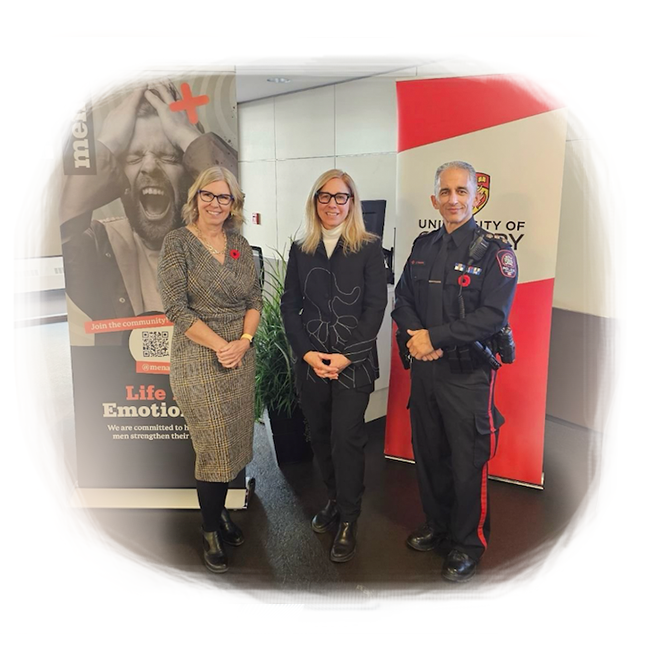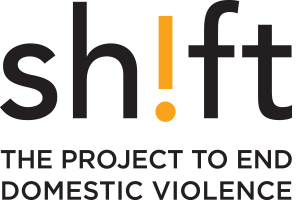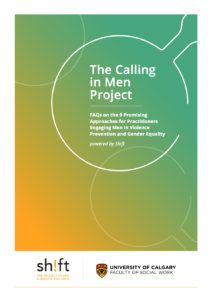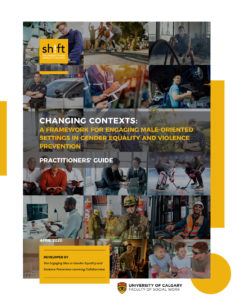ENGAGING MEN AND BOYS
Rationale
The research is clear: we need to engage men and boys. They are key to ending gender-based violence and discrimination.
But what does that look like? How do we help men and boys see themselves in this work? How do we reduce resistance and backlash, and tackle the influence of the ‘manosphere’? How do we build the will and skill to reduce violence and increase gender equality?
There is still very little research on the “how” of this work, and the existing research focuses primarily on programmatic approaches. While programs can be helpful, there are some limitations. First, many men and boys are unwilling to attend a program on violence prevention and gender equity. Second, programs focus on individual change but are usually limited in their capacity to change the social contexts in which those individuals exist.


Approach
How do we shift the cultural norms and expectations that impact thinking and behaviour? How do we create meaningful and sustained change? How do we move beyond the small pool of male allies to engage men and boys more broadly?
Shift has been exploring these questions for over a decade. In that time, we’ve:
- Reviewed countless policy and practice frameworks;
- Conducted research and evaluation;
- Worked with community and government partners; and
- Worked directly with men in a male-dominated profession.
Through these efforts, we have found that the following principles work to reduce resistance and increase engagement among men and boys – even those who have no particular interest in gender equity and violence prevention:
- We go to them: Rather than trying to recruit men and boys to come to programs in our spaces, we work in their spaces – in the places where they work, play, worship, and learn.
- We work to understand their priorities, fears, and concerns. Our research has demonstrated the importance of cultivating empathy and seeking to genuinely understand men’s/boy’s perspectives and concerns. You can’t change what you don’t understand.
- We work to shift social norms within a particular network. Research shows that our social environment has a profound influence on our behaviours. For this reason, individual changes achieved through a program can be lost when that person returns to his network of friends or coworkers. By focusing on changes in the network, individual changes are more likely to be sustained.
- We work with key influencers (or social referents) within a network. As humans, we are constantly looking to others in our network to figure out how we should behave. The people we tend to reference the most are those who are liked and respected – so that’s who we work with. We build the capacity of these ‘key influencers’ to signal a different set of expectations through small, everyday actions.
- We aim to achieve a tipping point. We work in a sustained way with about 25% of a setting. This percentage is based on tipping point research that suggests that when 25% of a network consistently adopts a new behaviour, the behaviour will spread to others in the network.
- We start with their priorities, not ours. We build trust and engagement by focusing on their priorities. When we help them solve the problems they want to solve, we gain their trust, enabling us to more effectively 1) engage in conversations that would otherwise have elicited eye-rolls or other dismissal, and 2) challenge existing ideas and behaviours.
- We focus on behaviours more than attitudes. Changing attitudes can be helpful, but that doesn’t always translate to behaviour change – which means that we can’t stop gender-based violence and discrimination through attitudes alone.
- We develop transferable skills. Men and boys are motivated to learn skills that align with their interests and motivations – so we use that as a starting point for engagement. For example, the ability to receive feedback from a coach or manager requires many of the same skills needed to reduce violence (e.g., self-regulation, managing thought distortions, active listening, and perspective-taking). Once we’ve built some trust, we help them connect these same skills to problems of gender-based violence and discrimination.
Our Work
2024
In 2024, in collaboration with the School of Public Policy and Calgary Police Service, Shift produced the first two reports in a policy series on understanding the histories and trajectories of male perpetrators of domestic violence. This groundbreaking work can help to focus legislation, policies, and practices on preventing the perpetration of domestic violence by engaging and supporting men at the right time.
In 2024, we presented 3 key policy recommendations – focused on disrupting trajectories of male violence – to the Legislative Assembly of Ontario’s Standing Committee on Justice Policy to inform their study on intimate partner violence.
2023
In 2023, we co-produced an article that presented findings from our national qualitative research study on 33 diverse and profeminist men leaders, taking an intersectional approach to articulating recommendations for engaging men and boys in creating a more gender-equal future in Canada.
2022
In 2022, Shift submitted a national strategy to the Government of Canada of evidence-based policies and practices to support the mobilization of more men and boys to stop violence before it starts and achieve gender and social justice.
In 2022, we submitted a provincial strategy to the Government of Alberta on building a movement of men and boys committed to violence prevention and gender equality. This report includes 4 key strategies and 12 concrete recommendations to engage men and boys as part of the solution to stop violence before it starts.
2021
In 2021, we responded to a call from the Government of Canada to create a recommendation on how to mobilize more men and boys in preventing gender-based violence and promoting gender equality, submitting a report to the Federal Minister for Women and Gender Equality and Rural Economic Development.
2020
In 2020, in partnership with the Engaging Men Learning Collaborative, we released Changing Contexts: A Framework for Engaging Male-Oriented Settings in Gender Equality and Violence Prevention - Practitioners’ Guide. The purpose of this practitioner’s guide is to support Human Services professionals to engage and mobilize men in male-dominated settings to advance gender equality and stop gender-based violence.
2019
In 2019, Shift completed a research study - Tomorrow’s Men Today: Canadian Men’s Insights on Engaging Men and Boys in Creating a More Gender Equal Future - to inform the development of a federal men’s engagement strategy. Post project, Shift was awarded funding to work with Next Gen Men to begin building a network of pro-feminist and feminist leaders across the country.
2018
In 2018, Shift released a report to demonstrate how the human services sector can better support the needs of men while furthering the goal of violence prevention: Serving Calgary Men across the Prevention Continuum. We also produced a report on the Perceptions of Gender Norms amongst Men and Boys to inform the development of a federal strategy to engage men and boys in advancing gender equality.
2017
In 2017, we launched the Engaging Men in Violence Prevention and Gender Equality Learning Collaborative. Comprised of practitioners, government representatives, and researchers from 14 organizations in Alberta, the collaborative was designed to develop non-programmatic approaches to engage men in violence prevention and gender equality in settings that they already spend time in.
2016
In 2016, Shift was awarded funding from the Government of Alberta and the United Way of Calgary and Area to help with the implementation of the Engaging Men and Boys Action Plan.
2015
In 2015, we released the Men and Boys Violence Prevention Project: Informing a Government of Alberta Action Plan to Engage Men and Boys to Stop Violence Against Women. Subsequently, we released No Man Left Behind: How and Why to Include Fathers in Government-Funded Parenting Strategies: a call to policymakers and community agencies to promote positive fatherhood and father-friendly practices as a violence prevention strategy.
2014
In 2014, we partnered with the Government of Alberta to develop the first-of-its-kind action plan in the Global North – to engage men and boys in preventing violence against women. The primary recommendation in the plan was to ensure that engaging men and boys is embedded in a broader, population-based approach to advance gender equality and prevent violence against women.
2013
In 2013, in partnership with White Ribbon Canada, we released Engaging Men and Boys in Domestic Violence Prevention: Opportunities and Promising Approaches. The report highlights 67 promising approaches in to advance this work in policy, programs and practices, and citizen-led initiatives.
In 2013, we released Promoting Positive Father Involvement: A Strategy to Prevent Intimate Partner Violence in the Next Generation. This report inspired a partnership with Catholic Family Services to implement a primary prevention strategy targeting teens and young fathers, ultimately leading to their new program: “Father’s Moving Forward”. As well, Shift co-hosted the Promoting Positive Fatherhood Collective, where over 40 local agencies and funders attended regular meetings to learn how to embed father-friendly practices throughout their organization.
2012
In 2011, Shift partnered with the Government of Alberta and identified “engaging men and boys to promote gender equality, respect and healthy relationships” as a key priority in the Family Violence Hurts Everyone: A Framework to End Family Violence in Alberta.
Projects
Learn more about other projects to engage men and boys from Shift.
Perpetrator Histories and Trajectories:
Using a robust 10-year dataset supplied by the Calgary Police Service, Shift is spearheading first-of-its-kind research in Canada on domestic violence perpetrators to understand both criminal histories and intervention opportunities.
The Calling In Men Research Project:
Through engaging with male-identified practitioners and subject matter experts from across the country, we developed in-depth research on 9 promising practices for engaging and mobilizing men in gender equality and violence prevention.
Engaging Men Learning Collaborative:
Shift convened a group of 14 government and human service agencies in 2017 to create non-programmatic approaches to engaging men in violence prevention and gender equality in settings where they already work, play, learn, live, and worship.





